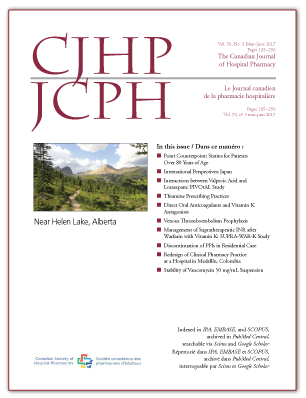Direct Oral Anticoagulants and Vitamin K Antagonists for Treatment of Deep Venous Thrombosis and Pulmonary Embolism in the Outpatient Setting: Comparative Economic Evaluation
DOI:
https://doi.org/10.4212/cjhp.v70i3.1658Keywords:
economic evaluation, cost-effectiveness, direct oral anticoagulants, venous thromboembolism, évaluation économique, rapport coût-efficacité, anticoagulants oraux directs, thromboembolie veineuseAbstract
ABSTRACT
Background: To date, there have been few economic evaluations, from a Canadian perspective, of direct oral anticoagulants (DOACs) for the prevention of recurrent venous thromboembolism (VTE) in patients with acute unprovoked VTE. As a result, there is a lack of consensus about which treatment strategy should be adopted in the clinical setting.
Objectives: To assess the cost-effectiveness of currently approved anti - coagulant options, in terms of cost per quality-adjusted life-year (QALY) gained, for the prevention of recurrent VTE in patients with unprovoked events managed on an outpatient basis.
Methods: Microsoft Excel was used to develop a Markov model. Model parameters were determined using published literature, local hospital data, expert opinion, and chart review. The analysis considered the costs associated with pharmaceuticals, laboratory testing, hematologist fees, and treatment of recurrent VTE and major bleeding events. Effectiveness was measured in terms of QALYs, and incremental cost-effectiveness ratios (ICERs) were calculated.
Results: For treatment lasting 3 months, apixaban represented the most cost-effective DOAC relative to low-molecular-weight heparin (LMWH) + vitamin K antagonist, with an ICER of $7379.66. For 6 months of treatment, apixaban again represented the most cost-effective treatment, with an ICER of $84.08 per QALY gained, and this drug dominated all the other strategies at 12 months. For lifetime treatment, DOACs were unlikely to be cost-effective, given a maximum willingness to pay of $50 000 to $100 000 per QALY. In a probabilistic sensitivity analysis at 6 months, 46.4% of iterations resulted in apixaban having lower costs and better outcomes than LMWH + vitamin K antagonist, and 78.6% of iterations resulted in an ICER below $100 000
Conclusions: The findings of this study suggest that apixaban is likely cost-effective for treatment durations of 3, 6, and 12 months. However, for indefinite treatment, DOACs were unlikely to be cost-effective.
RÉSUMÉ
Contexte : À ce jour, on a réalisé peu d’évaluations économiques, d’un point de vue canadien, sur les anticoagulants oraux directs (AOD) utilisés dans la prévention de la thromboembolie veineuse (TEV) récurrente chez les patients atteints de TEV idiopathique aiguë. Pour cette raison, aucun consensus n’a été établi quant à la stratégie thérapeutique à adopter en milieu clinique.
Objectif : Évaluer le rapport coût-efficacité des anticoagulothérapies actuellement approuvées, en ce qui a trait au coût par année de vie pondérée par la qualité (QALY) gagnée, pour la prévention de la TEV récurrente chez les patients ayant subi des événements idiopathiques qui ont été traités en consultation externe.
Méthodes : Le logiciel Excel de Microsoft a servi à créer un modèle de Markov. Les paramètres du modèle ont été établis à l’aide de la littérature, de données de l’hôpital local, d’opinions d’experts et d’une analyse de dossiers médicaux. L’analyse prenait en compte les coûts associés aux médicaments, aux examens de laboratoire, aux honoraires d’hématologues et au traitement de la TEV récurrente et d’hémorragies importantes. L’efficacité était mesurée en nombre de QALY et les rapports coûtefficacité différentiels ont été calculés.
Résultats : Pour un traitement de trois mois, l’apixaban représentait l’AOD offrant le meilleur rapport coût-efficacité comparativement à l’héparine de bas poids moléculaire (HBPM) + un antagoniste de la vitamine K; il présentait un rapport coût-efficacité différentiel de 7379,66 $. Pour un traitement de six mois, l’apixaban représentait à nouveau le traitement le plus efficace par rapport au coût; il présentait un rapport coût-efficacité différentiel de 84,08 $ par QALY gagnée. Ce médicament surclassait toutes les autres stratégies après douze mois de traitement. En ce qui concerne un traitement à vie, les AOD offraient probablement un moins bon rapport coût-efficacité, compte tenu d’une propension à payer maximale se situant entre 50 000 $ et 100 000 $ par QALY. Dans une analyse de sensibilité probabiliste au sixième mois de traitement, 46,4 % des itérations se traduisaient par des coûts moins élevés et de meilleurs résultats pour l’apixaban relativement à l’HBPM + un antagoniste de la vitamine K. De plus, 78,6 % des itérations se traduisaient par un rapport coût-efficacité différentiel de moins de 100 000 $.
Conclusions : Ces résultats laissent croire que l’apixaban présente probablement un rapport coût-efficacité intéressant pour les traitements d’une durée de 3, 6 et 12 mois. Cependant, en ce qui concerne un traitement d’une durée indéterminée, les AOD ne sont sans doute pas avantageux.
Downloads
Published
Issue
Section
License
Copyright © Canadian Society of Healthcare-Systems Pharmacy.
After publication of a manuscript in the CJHP, the authors of the manuscript must obtain written permission from the CSHP (publications@cshp.ca) before reproducing any text, figures, tables, or illustrations from the work in future works of their own. If a submitted manuscript is declined for publication in the CJHP, all said rights shall revert to the authors. Please note that any forms (e.g., preprinted orders and patient intake forms) used by a specific hospital or other health care facility and included as illustrative material with a manuscript are exempt from this copyright transfer. The CJHP will require a letter from the hospital or health care facility granting permission to publish the document(s).










